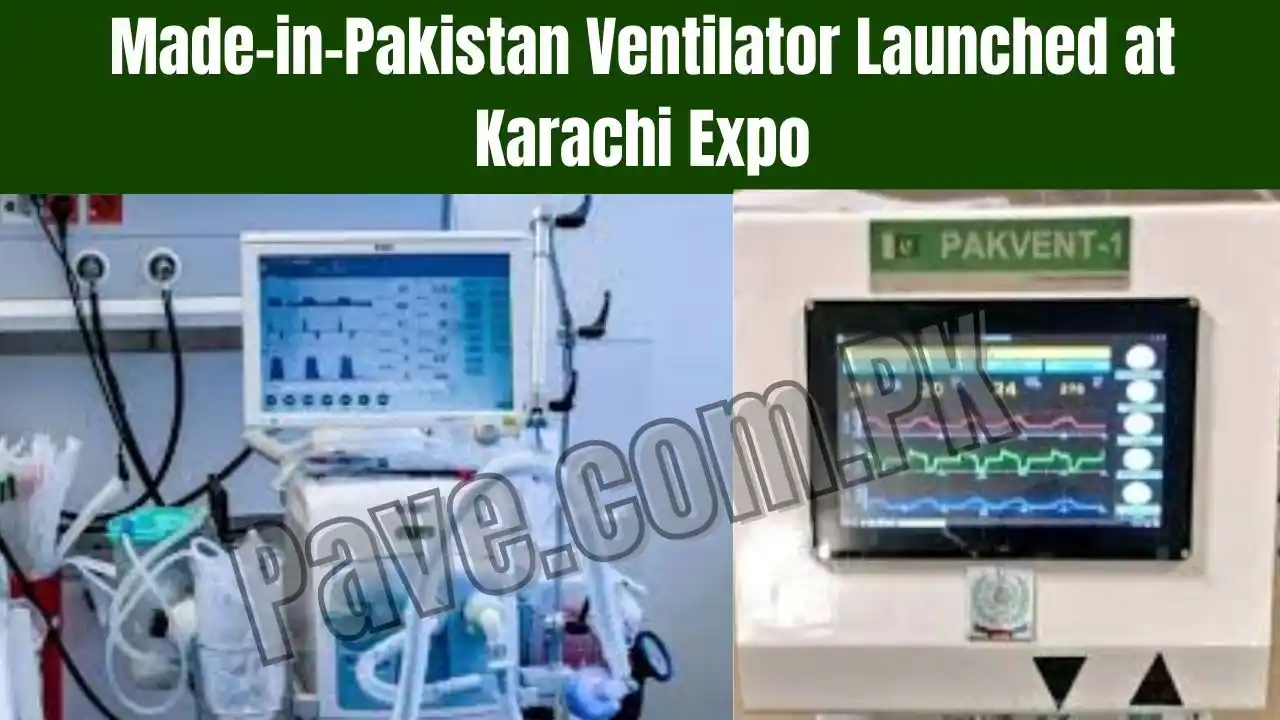Made-in-Pakistan Ventilator Launched at Karachi Expo – Complete Details
Pakistan has reached another significant milestone in the field of medical technology with the launch of a locally manufactured ventilator showcased at the Karachi Expo Center. This breakthrough reflects the country’s growing capabilities in medical engineering, healthcare innovation, and indigenous manufacturing. As healthcare systems worldwide focus on self-reliance and resilient medical supply chains, Pakistan’s venture into producing ventilators locally marks a turning point for national medical preparedness.Made-in-Pakistan Ventilator Launched at Karachi Expo
Ventilators are among the most critical life-saving machines used in intensive care units (ICUs) to support patients suffering from severe respiratory diseases and critical lung failure conditions. During global emergencies such as pandemics, supply shortages and international export restrictions exposed vulnerabilities in countries relying solely on imported life-support devices. Pakistan’s step toward local development not only strengthens healthcare readiness but also reduces dependency on foreign suppliers.
Who Developed the Ventilator?
The indigenous ventilator showcased at Karachi Expo was developed through collaboration between:
- Pakistani biomedical engineers
- Local manufacturing firms
- Technical universities
- Healthcare research institutes
Government support, combined with engineering expertise, streamlined development and regulatory approval.
This reflects a growing ecosystem of health-tech innovation within the country.
Read Also: WhatsApp SIM Activation & Service Management Launched by Telenor Pakistan
Key Features of the Made-in-Pakistan Ventilator
The ventilator comes equipped with various modern features, including:
- Adaptive mechanical ventilation for adult and pediatric patients
- Real-time monitoring of oxygen saturation and airflow
- Touchscreen interface for ICU staff ease
- Emergency alarm systems and safety controls
- Battery backup for power fluctuation zones
- Robust hardware resistant to local climate conditions
These features ensure functionality in both advanced hospitals and remote healthcare units.
Cost Advantage
The local ventilator dramatically reduces cost compared to imported alternatives. While imported units can cost hundreds of thousands of rupees — often exceeding hospital budgets — the Made-in-Pakistan model:
- Minimizes procurement expenses
- Eliminates high import duties
- Reduces logistical delays
- Provides affordable maintenance
Hospitals can now acquire life-saving devices more easily and in greater quantity.
Contribution to Healthcare Self-Reliance
Pakistan’s reliance on international medical supply chains has historically caused:
- Procurement delays
- Pricing fluctuations
- Equipment shortages during crises
Local innovation ensures that during epidemics, respiratory outbreaks, and seasonal emergencies, hospitals remain equipped with functional ventilators.
Economic Impact and Job Creation
The production of medical devices within Pakistan generates employment in:
- Engineering design
- Component assembly
- Research laboratories
- Quality control
- Technical servicing
It stimulates the biomedical industry and supports skilled labor growth.
Compliance With Safety Standards
The ventilator has undergone:
- Clinical testing
- Regulatory approval stages
- Expert evaluation by medical boards
International safety protocols ensure reliability and prevent equipment-related risks.
Role in Emergency Response
Local ventilators are essential during:
- ICU bed surges
- Disease outbreaks (influenza, pneumonia, COVID-like conditions)
- Disaster management
- Rural healthcare support
Mobile transport units equipped with ventilators can help save lives even during ambulance transfers.
Availability in Rural Hospitals
Remote hospitals struggle to purchase or service foreign ventilators. The local model:
- Uses easily accessible spare parts
- Requires minimal technical training
- Features simple controls for quick onboarding
This increases healthcare accessibility beyond major cities.
Future Expansion and Export Potential
With mass-scale production, Pakistan may eventually:
- Supply ventilators to neighboring developing nations
- Reduce international dependency among low-income countries
- Become a regional exporter of affordable medical technology
Such growth positions Pakistan on the global medical equipment manufacturing map.
Public and Expert Response
Healthcare professionals attending the Karachi Expo praised:
- Device affordability
- Innovative engineering
- Clean, user-friendly interface
Government officials hailed it as a step toward economic and medical independence.
Pakistan’s Growing Health-Tech Sector
Over the past five years, Pakistan has increased investment in:
- Digital diagnostics
- Wearable health monitoring
- Mobile health apps
- Indigenous ICU equipment
The ventilator project aligns with national digital health goals and self-sufficiency policies.
A ventilator is a life-support medical device designed to assist or fully control a patient’s breathing when they are unable to breathe effectively on their own. It ensures the delivery of oxygen and removal of carbon dioxide from the lungs under carefully controlled settings.
1. Air Intake and Oxygen Supply
Ventilators draw in filtered room air and combine it with medical-grade oxygen.
This mixture is adjustable depending on:
- The patient’s condition
- Blood oxygen level
- ICU treatment plan
Flow regulators ensure the correct ratio of oxygen-to-air mix.
Read Also: Scotland Work Visa Latest November Update New Rules & Application Flow
2. Compression and Pressurization
Inside the ventilator, an electric-powered pump or turbine pressurizes the combined air mixture.
This controlled pressure allows the ventilator to push air into the lungs even when a patient’s chest muscles are weak or paralyzed.
3. Delivery Through Breathing Circuit
The pressurized air flows through:
- Tubes (breathing circuit)
- Humidifier
- Filters
It then reaches the patient’s lungs via:
- Endotracheal tube (for ICU patients)
or - Mask-based ventilation (non-invasive)
4. Inspiration Cycle (Breath In)
During the inspiration phase:
- The ventilator opens its inhalation valve
- Air is delivered with controlled volume or pressure
- The patient’s lungs inflate smoothly
The ventilator can completely control the timing, or synchronize with the patient’s natural breaths.
5. Expiration Cycle (Breath Out)
When the set breathing time ends:
- The inhalation valve closes
- Exhalation valve opens
- Air leaves the lungs passively through natural recoil
The ventilator measures volume and pressure to ensure effective exhalation.
6. Monitoring Gas Exchange
Ventilators constantly monitor:
- Oxygen saturation (SpO₂)
- Carbon dioxide (CO₂)
- Airflow rate
- Pressure levels
- Tidal volume (amount of inhaled air)
These indicators tell doctors whether the patient is improving or declining.
7. Humidification and Heating
Ventilated air must be:
- Moisturized (humidified)
- Warmed to body temperature
This prevents dryness and damage inside the lungs.
8. Alarm and Safety Systems
Ventilators include alarms for:
- Low oxygen pressure
- Blocked tubes
- High airway pressure
- Patient disconnection
- Power failure
These alarms protect the patient from life-threatening situations.
9. Types of Ventilation Modes
Different medical modes include:
- Volume-Controlled Ventilation (VCV): Delivers a fixed air volume each breath
- Pressure-Controlled Ventilation (PCV): Limits pressure to protect lungs
- Assist-Control (AC): Supports each patient-initiated breath
- SIMV: Combines mandatory and spontaneous breaths
- BiPAP/CPAP: Used for non-invasive support
Doctors select modes based on lung condition.
10. Weaning Process
When a patient improves:
- Ventilation support is gradually reduced
- The patient tries breathing independently
- Doctors observe if lungs can handle workload
Once stable, the ventilator tube is removed.
Read Also: BISE Lahore 11th Class Result 2025: Check 1st Year Annual Result Easily
Conclusion
The launch of a Made-in-Pakistan ventilator at the Karachi Expo Center represents a major leap forward in local medical innovation and national resilience. By producing lifesaving equipment domestically, Pakistan moves toward a stronger healthcare system, capable of handling emergencies without external reliance. The ventilator’s affordability, reliability, and adaptability make it accessible across urban and rural hospitals alike.
This development not only boosts confidence in local research capabilities but also inspires future biomedical advancements across Pakistan. With continued investment and support, the country could soon emerge as a recognized contributor to global medical technology markets.







